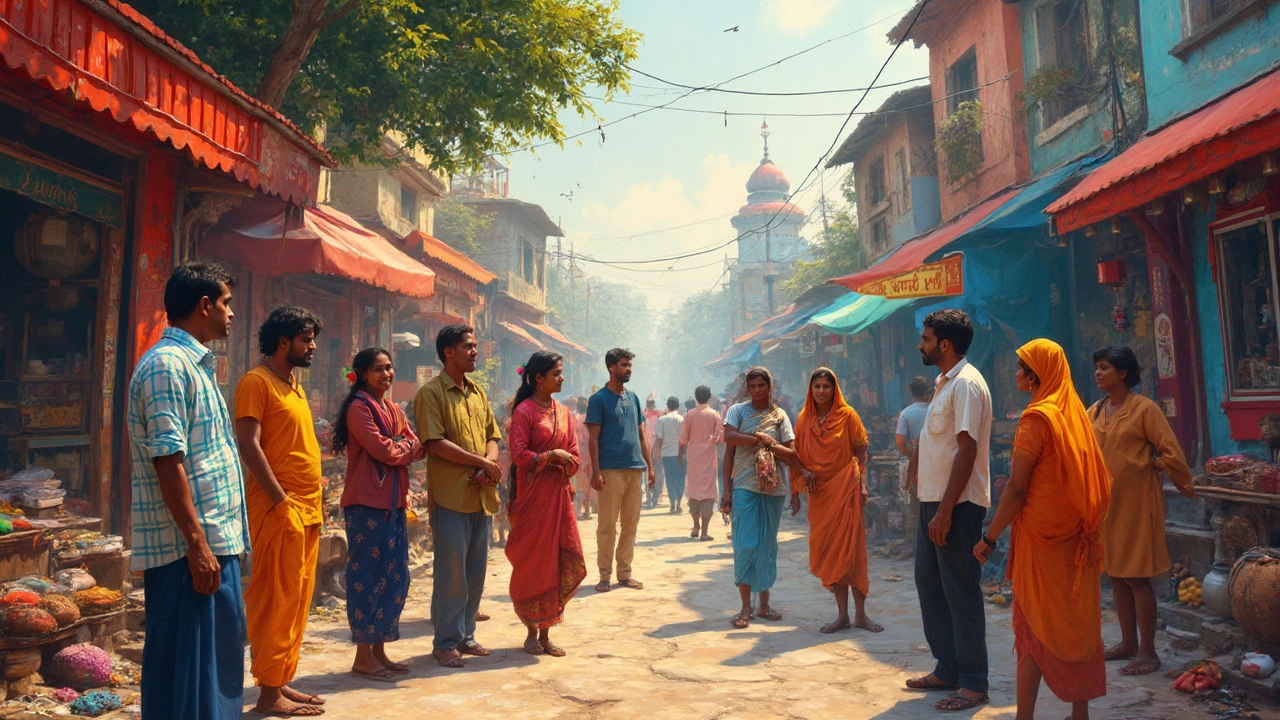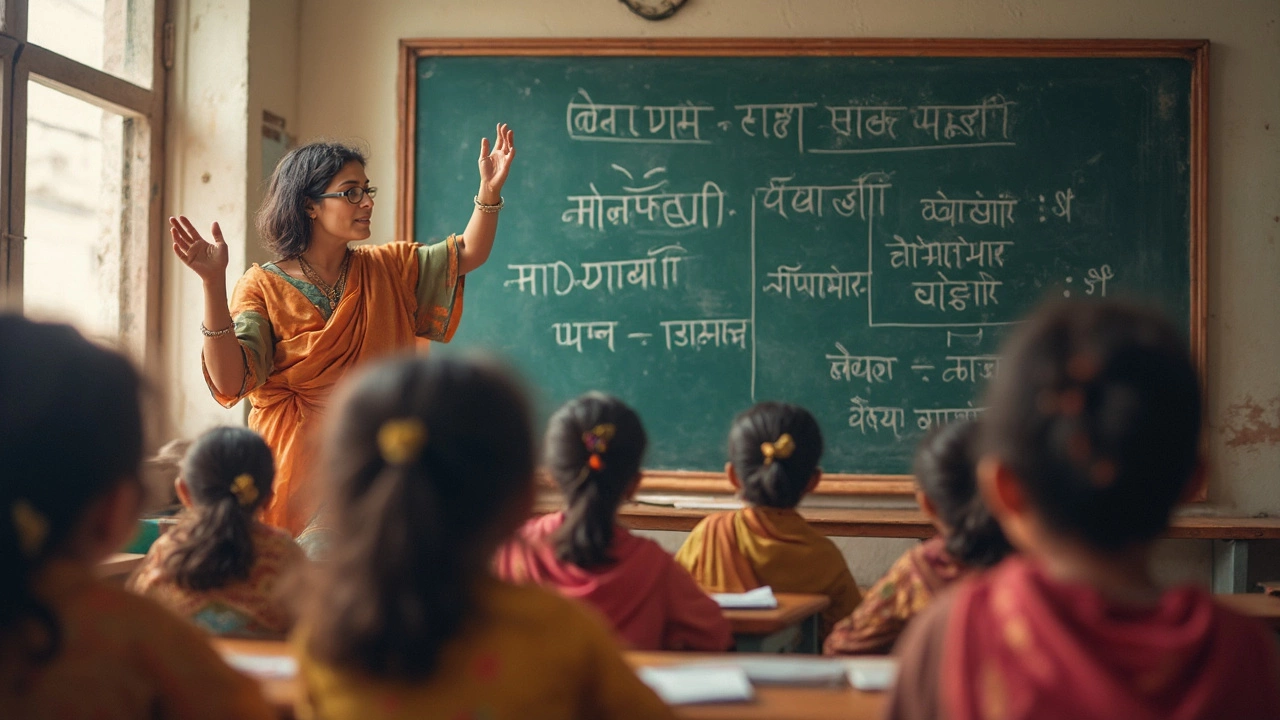The Most Widely Spoken Language in India: Hindi
 Apr, 12 2025
Apr, 12 2025
India, with its rich tapestry of culture and language, offers a fascinating linguistic journey. At the heart of it all is Hindi, the language that acts like a thread weaving through states and communities. Spoken by over 40% of the population, Hindi isn’t just a language; it’s like a bridge, connecting diverse groups in this large nation.
This might surprise some, given the countless languages and dialects thriving here. The story of Hindi’s growth is linked to history, migration, and a bit of Bollywood magic making it popular beyond the Hindi-belt. What's really cool? It’s not just formal Hindi we’re talking about. Dialects and variations make each region's version unique, giving voice to local flavors and expressions.
- Hindi's Position in India
- Historical Roots and Evolution
- Regional Variations and Dialects
- Impact on Education and Media
- Practical Tips for Learning Hindi
Hindi's Position in India
If you’ve ever wondered which language holds the most sway in India, look no further than Hindi. With its roots nestled deep in the Indo-Aryan family, Hindi is the mother tongue of about 528 million people. That's like saying almost every one out of two people in India embraces Hindi either as their first language or uses it for daily conversations.
Officially, Hindi is recognized as one of the two languages for central government work, the other being English. This status gives it a formal edge, making it a go-to language in government paperwork and even politics. Decision-makers often prefer Hindi when they rally the masses, which gives it a significant boost in reach and influence.
Here's a stat you might find interesting. In many schools across the nation, Hindi not only serves as the primary medium of instruction but also as the second language in non-Hindi speaking regions. This leads to a melting pot of dialects, with folks from South India to the North-east adding their own linguistic twist.
Another big influence? The entertainment industry, no surprise there! Bollywood movies have been instrumental in taking Hindi to every nook and corner of India, and across the globe. Whether it’s a catchy tune or a dramatic dialogue, movies have extended Hindi’s charm beyond native speakers.
| State | Speakers (% of state population) |
|---|---|
| Uttar Pradesh | 93% |
| Madhya Pradesh | 88% |
What does all this mean for you? If you’re planning to visit or work in India, picking up a bit of Hindi could open doors – literally and figuratively. It's your ticket to making connections and blending in with the local vibe.
Historical Roots and Evolution
To get how Hindi became the most widely spoken language in India, we gotta rewind to when it all started. Back in the ancient days, the local languages in India were heavily influenced by Sanskrit. Over time, and especially during the rise of medieval kingdoms, these languages started evolving. Hindi as we know it today, began forming around the 7th century, picking up bits from Prakrit and Apabhramsha, which were the languages used by common folks in those days.
Then came the Muslim rulers during the medieval period. This is when Persian mixed with local dialects, adding new words and flavor to what would become Hindi. Fast-forward to the British Raj, where Hindi was formalized as a distinct language, separating it from Urdu, which had a common origin but leaned more on Persian influences.
In 1949, a year after India gained independence, Constituent Assembly of India took a pivotal step by adopting Hindi as an official language of the Republic of India. Why? They needed a common tongue to unite diverse linguistic groups. Of course, this didn’t just happen without debate. Other regions were eager to preserve their languages, and strong sentiments for regional languages still exist today.
Sadly, this evolution isn't just breezy stories of blending cultures. There’s a long list of regional tussles and political decisions swirling around the use of Hindi. But, despite the challenges, Hindi's influence pushed forward, with more than 600 million speakers today.
| Year | Milestone |
|---|---|
| 7th Century | Origins linked to Prakrit and Apabhramsha |
| 12th-16th Century | Influence from Persian under Muslim rule |
| 1949 | Hindi adopted as the official language post-independence |
This mix of historical exchanges shows why Hindi isn’t just a language, but a cultural mashup of diverse influences throughout history. It teaches us how languages are never static; they shift, evolve, and integrate elements from various influences around them, becoming richer and more inclusive.

Regional Variations and Dialects
Let's dive into the many shades of Hindi across India. While the core language forms a common thread, its dialects spin out vibrant regional tapestries. From Rajasthani to Bhojpuri, these variations bring out the unique cultural essence of different areas.
In the northern plains, Bhojpuri, spoken in eastern Uttar Pradesh and western Bihar, is a crowd favorite. It's not just a language, but a part of the area's lifestyle, often heard in folk songs and movies. Travel a bit west, and you'll hear Marwari in Rajasthan, a dialect full of history and tradition, lending its charm to the majestic region.
Then there’s Awadhi, a dialect with its roots deep in the heart of Avadh region. Famous for its sweet and soft tone, Awadhi can be found in the epic tale of Ramayana, making it historically significant too. In the Delhi region and parts of Haryana, Haryanvi is the dialect of choice—bringing its own rustic rhythm to everyday conversations.
India’s linguistic diversity doesn’t stop here. Many of these dialects have strong influences on local languages and often blend several linguistic elements. This intermingling shows how language adapts and survives in the cultural melting pot that is India. Mastering Hindi in its various forms can offer a deeper look into India's vast cultural landscape, enhancing both personal interactions and professional ties.
Impact on Education and Media
When it comes to the world of education in India, Hindi holds its ground as a major player. Beyond the primary and secondary levels, many colleges and universities offer courses in Hindi, not just as a subject but also as a medium of instruction for various disciplines. For millions of students, learning in Hindi feels natural, connecting educational content with their everyday lives. This ensures that vast swathes of the population have access to education in a language they’re comfortable with.
In the media landscape, Hindi is the undisputed king. Think about Indian TV shows, news channels, and the booming Bollywood industry – Hindi dominates them all. Turn on the TV, and you'll likely find a range of programs, from soap operas to news broadcasts, primarily in Hindi. This isn't just about making Hindi-speaking audiences happy; it helps draw in non-native speakers as well, making Hindi an influential force in shaping popular culture.
Let’s not forget about the role of Hindi in digital media. With the rise of the internet, Hindi content is getting its moment in the sun. From online news portals to YouTube channels, there's a growing shift towards Hindi content. This evolution means more people can access information, entertainment, and education in their mother tongue.
Check out the numbers supporting this growth:
| Medium | Hindi Usage |
|---|---|
| TV Channels | 90% |
| Newspapers | 60% |
| Online Content | Rapid Growth |
The influence of Hindi in education and media isn’t just statistical; it’s a testament to its evolving role in an interconnected world. So, whether you’re flipping through TV channels or reading online, Hindi is right there, making its presence known.

Practical Tips for Learning Hindi
Learning Hindi can be super rewarding and not as hard as it might seem. Don't expect to be quoting poetry in a week, but you can definitely pick up enough to chat with the locals without feeling like an outsider.
First off, start with the Hindi alphabet. It's called Devanagari, and it might look a bit strange at first, but it's phonetic. Once you get the hang of it, pronunciation becomes much easier. Flashcards can be really handy here. Don’t skip this step.
- Immerse Yourself: Dive into Hindi media like Bollywood movies, songs, and even news channels. You'll pick up phrases and improve your listening skills. Don’t worry if you don’t understand every word; just enjoy the process.
- Use Language Apps: Apps like Duolingo or Rosetta Stone offer structured courses. They provide a mix of reading, writing, and speaking exercises. Regular practice here can be a game-changer.
- Speak with Native Speakers: Have a chat with a friend who speaks Hindi. Or find a conversation partner online. Real-life practice will boost your confidence.
- Try Short Stories: Children’s books in Hindi are great resources for beginners. They use simple words that are easy to grasp.
- Labels Around You: Label items in your house in Hindi. It’s a simple yet effective way to build vocabulary.
To make your target clearer, here’s a fun tip! Track your progress with small goals, like learning 5 new words a day. In no time, you'll feel more comfortable with not only speaking but understanding the culture. Happy learning!